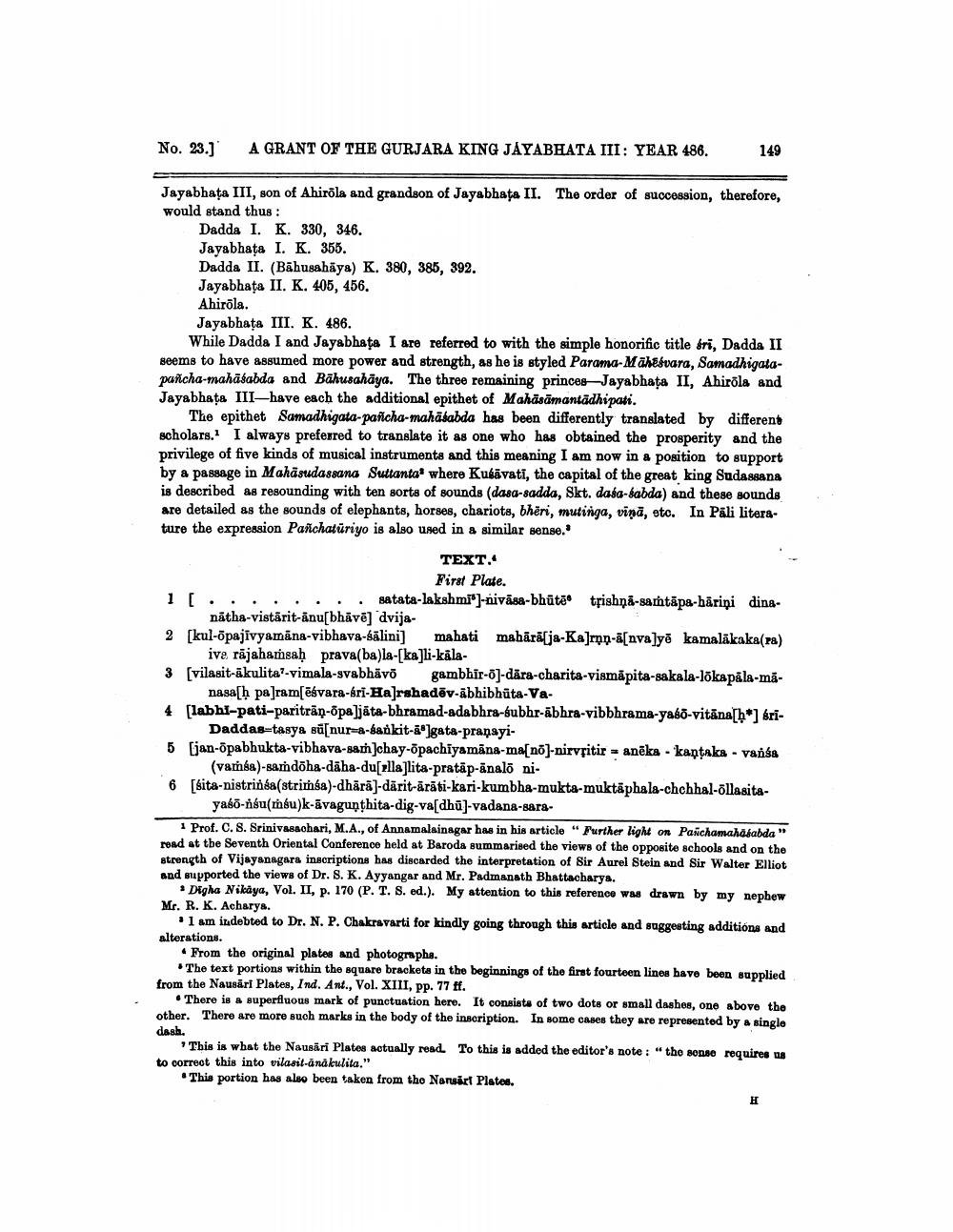________________
No. 23.)
A GRANT OF THE GURJARA KING JÁYABHATA III: YEAR 486.
149
S
Jayabhata III, son of Ahirola and grandson of Jayabhata II. The order of succession, therefore, would stand thus :
Dadda I. K. 330, 346. Jayabhata I. K. 355. Dadda II. (Bahusahāya) K. 380, 385, 392. Jayabhata II. K. 405, 456. Ahirola.
Jayabhata III. K. 486.
While Dadda I and Jayabhata I are referred to with the simple honorific title fri, Dadda II seems to have assumed more power and strength, as he is styled Parama-Māhesvara, Samadhigatapancha-mahāśabda and Bāhusahāya. The three remaining princes—Jayabhata II, Ahirola and Jayabhata III—have each the additional epithet of Mahäsämantādhipati.
The epithet Samadhigata-paitcha-mahatabda has been differently translated by different scholars. I always preferred to translate it as one who has obtained the prosperity and the privilege of five kinds of musical instruments and this meaning I am now in a position to support by a passage in Mahasudassana Suttantawhere Kulāvati, the capital of the great king Sudassana is described as resounding with ten sorts of sounds (dasa-sadda, Skt. dasa-labda) and these sounds are detailed as the sounds of elephants, horses, chariots, bhëri, mutinga, viņā, etc. In Pāli literature the expression Panchatūriyo is also used in a similar sense.'
TEXT.
First Plate. 1 [ .. . ... .. satata-lakshmi')-nivasa-bhūtë trishņā-santapa-birini dina
nātha vistārit-anu[bhāvē] dvija2 [kul-opajivyamana-vibhava-sālini] mahati mahārā[ja-Ka]ron-a[nva]yo kamalakaka(ra)
iva rajahamsaḥ prava(ba)la-[ka]li-kala3 (vilasit-akulita-vimala-svabhävo gambhir-6]-dara-charita-vismāpita-sakala-lokapāla-ma
nasa[h param[ēsvara-bri-Ha]rshadēv-ábhibhūta Va 4 [labhl-pati-paritrāņ-opa]jāta-bhramad-adabhra-subhr-abhra-vibbhrama-yabő-vitāna[h*) sri
Daddas-tasya sā[nur-a-bankit-agata-pranayi5 [jan-opabhukta-vibhava-sam Jchay-õpachiyamāna-ma[no]-nirveitir = anēka - kantaka - vansa
(varsa)-samdöha-dāha-du[zllallita-pratāp-analo ni6 [sita-nistrinsa(strimsa)-dhārā]-därit-arāti-kari-kumbha-mukta-muktāphala-chchhal-ollasita
yaso-nsu(mbu)k-āvagunthita-dig-va[dhū]-vadana-sara1 Prof. C. S. Srinivasachari, M.A., of Annamalainagar has in his article " Further light on Panchamahababda" road at the Seventh Oriental Conference held at Baroda summarised the views of the opposite schools and on the strength of Vijayanagara inscriptions has discarded the interpretation of Sir Aurel Stein and Sir Walter Elliot and supported the views of Dr. S. K. Ayyangar and Mr. Padmanath Bhattacharya.
Digha Nikaya, Vol. II, p. 170 (P. T. S. ed.). My attention to this reference was drawn by my nephew Mr. R. K. Acharys.
• 1 sm indebted to Dr. N. P. Chakravarti for kindly going through this article and suggesting additions and alterations.
. From the original plates and photographe.
The text portions within the square bracketa in the beginnings of the first fourteen lines have been supplied from the Nausāri Plates, Ind. Ant., Vol. XIII, pp. 77 ff.
• There is a superfluous mark of punctuation here. It consists of two dots or small dashes, one above the other. There are more such marks in the body of the inscription. In some cases they are represented by a single dash,
This is what the Nausari Plates actually read. To this is added the editor's note : "the sonso requires us to correct this into vilasit-anakulita."
* This portion has also been taken from tho Nansart Plates.




